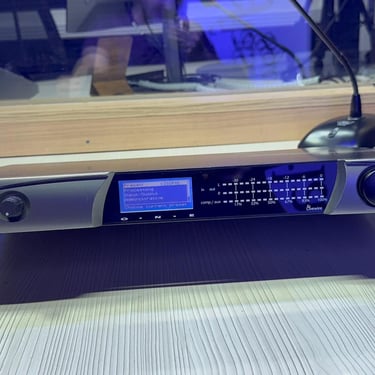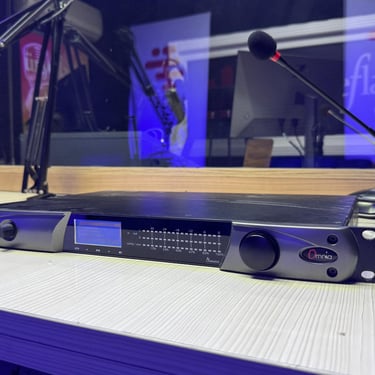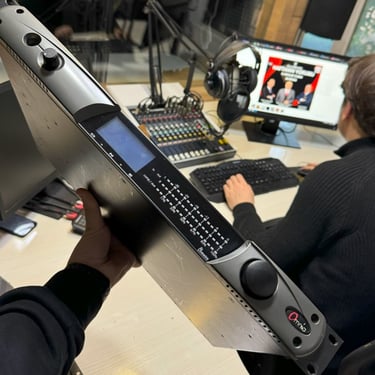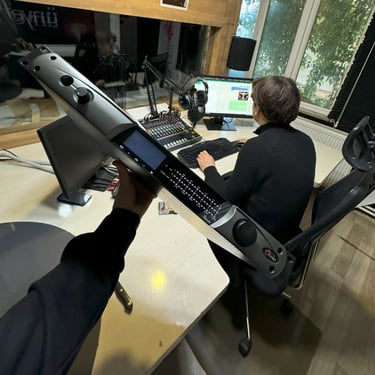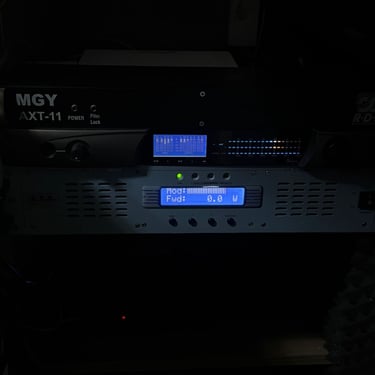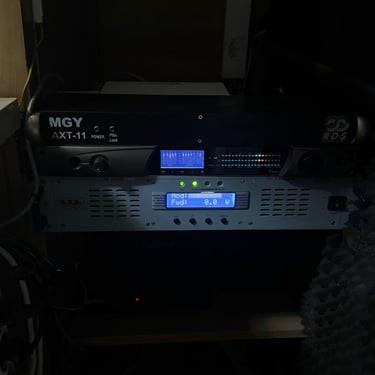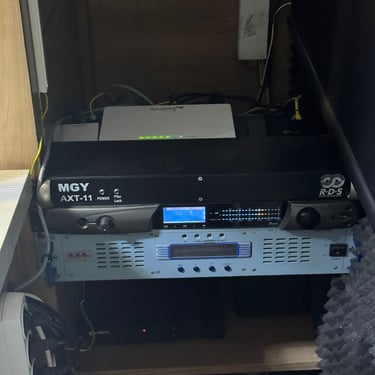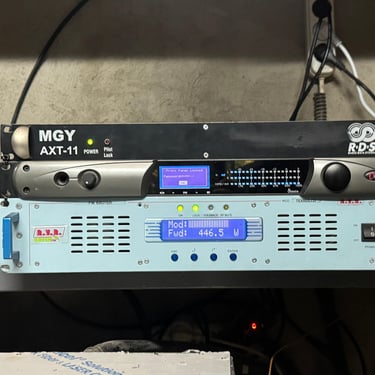Technical Overview of Omnia One FM, RVR Tex 502 LCD, and RDS System
Radio broadcasting technology has evolved rapidly in recent years. To deliver higher sound quality and more efficient broadcasting experiences, professional broadcasters and amateur radio station owners alike rely on a variety of specialized devices. This article provides a detailed technical overview of three key components used in modern radio broadcasting: the Omnia One FM, the RVR Tex 502 LCD transmitter, and the RDS (Radio Data System) technology.
AYBERK BLOG
In-Depth Technical Overview of Omnia One FM, RVR Tex 502 LCD, and RDS System
Radio broadcasting technology has evolved rapidly in recent years. To deliver higher sound quality and more efficient broadcasting experiences, professional broadcasters and amateur radio station owners alike rely on a variety of specialized devices. This article provides a detailed technical overview of three key components used in modern radio broadcasting: the Omnia One FM, the RVR Tex 502 LCD transmitter, and the RDS (Radio Data System) technology.
Omnia One FM Device: Detailed Technical Review
The Omnia One FM is a digital audio processor designed to optimize sound quality in FM radio broadcasts. Known for its compact design and high-performance processing capabilities, the Omnia One provides broadcasters with powerful tools to enhance their sound.
Audio Processing Technologies:
Dynamic Processor:
The Omnia One FM features a dynamic processor that manages the dynamic range of the broadcast signal. It reduces the difference between the loudest and softest sounds, ensuring a balanced output where music and speech have equal prominence, even in varying volume environments.Stereo Expander:
The stereo expander enhances the stereo image by improving the separation between the left and right audio channels. This feature adds more depth and width to the sound, making the broadcast more immersive.Frequency Response & Adjustment:
Omnia One FM adjusts frequency response to eliminate distortion in the low frequencies (such as bass) and improve the overall clarity of the signal. This is particularly beneficial for creating fuller sound profiles and richer tonal qualities.Limiter:
The limiter function prevents audio signals from exceeding a set threshold, preventing distortion and clipping. By automatically adjusting volume peaks, the Omnia One ensures consistent sound quality without unwanted signal overdrive.Loudness Maximizer:
This feature allows broadcasters to maintain maximum loudness without compromising audio quality. The loudness maximizer optimizes loudness levels across various frequency bands, ensuring that the broadcast remains powerful and consistent.
Connection and Application Areas:
Omnia One FM offers Ethernet connectivity, which allows remote monitoring and control of the device, making it convenient for broadcasters to manage settings from a distance. Additional connection options like USB and GPIO ports also allow for integration with external equipment such as backup power sources or remote control systems.
Due to its compact size (1U rack-mountable), the Omnia One FM is ideal for use in small to medium-sized radio stations, internet radio broadcasters, and music-focused programs.
RVR Tex 502 LCD FM Transmitter: In-Depth Analysis
The RVR Tex 502 LCD is a powerful yet compact FM transmitter designed for high-quality FM radio broadcasting. It’s typically used by medium-sized radio stations and offers a combination of performance, ease of use, and affordability.
Frequency and Modulation:
Frequency Range (87.5 MHz - 108 MHz): The RVR Tex 502 operates in the standard FM broadcast band, covering the 87.5 MHz to 108 MHz range. This wide frequency range gives broadcasters the flexibility to select the best available frequency for their needs.
FM Modulation: The device uses FM (Frequency Modulation) for analog audio transmission. FM modulation is ideal for long-distance signal transmission with minimal audio distortion. It provides superior sound quality, ensuring a faithful reproduction of the original audio source.
Power Consumption and Efficiency:
One of the key advantages of the RVR Tex 502 is its low power consumption. Despite delivering a strong output signal, it is energy-efficient, making it ideal for long-term, continuous broadcasting without significant power drain.
Cooling System for Extended Use:
The transmitter includes a built-in cooling system to prevent overheating during prolonged use. This is crucial for maintaining performance over extended periods, ensuring that the transmitter operates at full capacity without compromising on reliability.
LCD Display and User-Friendly Interface:
The RVR Tex 502 features a clear and intuitive LCD display that allows users to monitor all relevant parameters (output power, frequency, temperature, etc.) in real-time. The user interface is designed for ease of use, allowing both technical and non-technical operators to manage the device effectively.
Output Power and Modulation Performance:
Output Power: The RVR Tex 502 offers an output power of up to 50W, which is suitable for city-level broadcasts or short-range transmissions.
Harmonic Distortion: The transmitter boasts low harmonic distortion levels, ensuring clean and undistorted audio output. This is important for maintaining high sound quality, especially in professional broadcasting environments.
RDS (Radio Data System) Technology: Detailed Explanation
The RDS (Radio Data System) is a technology used in FM radio broadcasts that allows the transmission of additional digital data alongside the audio signal. This data can include a variety of information such as station identification, song titles, news, and other metadata, enhancing the listener's experience.
How RDS Works:
RDS operates by encoding additional data into the FM broadcast signal in a subcarrier band, typically at 57 kHz. This data is transmitted along with the audio signal, but does not interfere with the main FM transmission. RDS receivers are then able to decode and display this information to the listener in real-time.
Key RDS Features:
Program Service (PS) and Station Identification:
The Program Service (PS) function is used to display the station's name on the listener's receiver. For example, when tuning into a station, the RDS receiver might display the station name as "RADIO X."Alternative Frequencies (AF):
The AF feature allows RDS receivers to automatically switch to the best available frequency if the signal becomes weak or experiences interference. For example, if a listener is traveling and moves out of range of one frequency, RDS will seamlessly switch to another frequency broadcasting the same station.Program Type (PTY):
PTY codes indicate the type of programming currently being broadcast. For instance, PTY could indicate whether the program is "Pop Music," "News," "Sports," or another category. This allows listeners to identify the content type they are listening to.Clock and Date Information:
Some RDS systems also transmit time and date information to help listeners keep track of time while listening to the radio.Song Title and Artist Information:
RDS can transmit information about the song or program currently being played, such as the song title, artist, or even the name of the current radio show. This feature is especially useful for music stations, allowing listeners to know what they are listening to in real-time.Advertisements and Sponsorships:
RDS can also be used for promotional purposes. Radio stations can send text-based advertisements or sponsorship information to listeners, providing additional revenue opportunities.
Benefits of RDS:
Seamless Listening Experience: RDS ensures that listeners experience uninterrupted broadcasts by automatically switching to the best frequency.
Improved Listener Engagement: By providing extra information such as song titles, artist names, and program types, RDS improves the listener’s overall engagement with the broadcast.
Commercial Opportunities: Advertisers can use RDS to transmit additional branded content, sponsorship messages, or other promotions, helping radio stations monetize their broadcast more effectively.
RDS in Modern Broadcasting:
While RDS started as a tool for broadcasting in Europe in the 1980s, it has since gained global adoption. It is now a standard feature in FM radio broadcasts worldwide and provides stations with a way to connect with their audience beyond just the audio content.
Conclusion
The Omnia One FM provides advanced audio processing capabilities to enhance the quality of FM radio broadcasts, ensuring a professional sound for any station. The RVR Tex 502 LCD transmitter is a versatile and reliable solution for medium-powered FM broadcasts, offering ease of use and energy efficiency. Meanwhile, the RDS system adds value by transmitting additional data, offering listeners more interactive and informative broadcasting experiences. These technologies collectively play a pivotal role in modern radio broadcasting, providing better sound quality, greater flexibility, and enhanced listener engagement. As the broadcasting industry continues to evolve, the integration of these systems helps broadcasters stay ahead in a highly competitive market.
